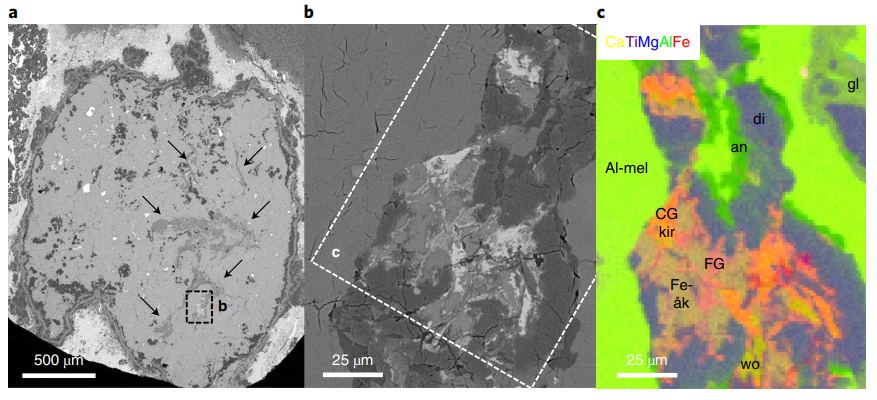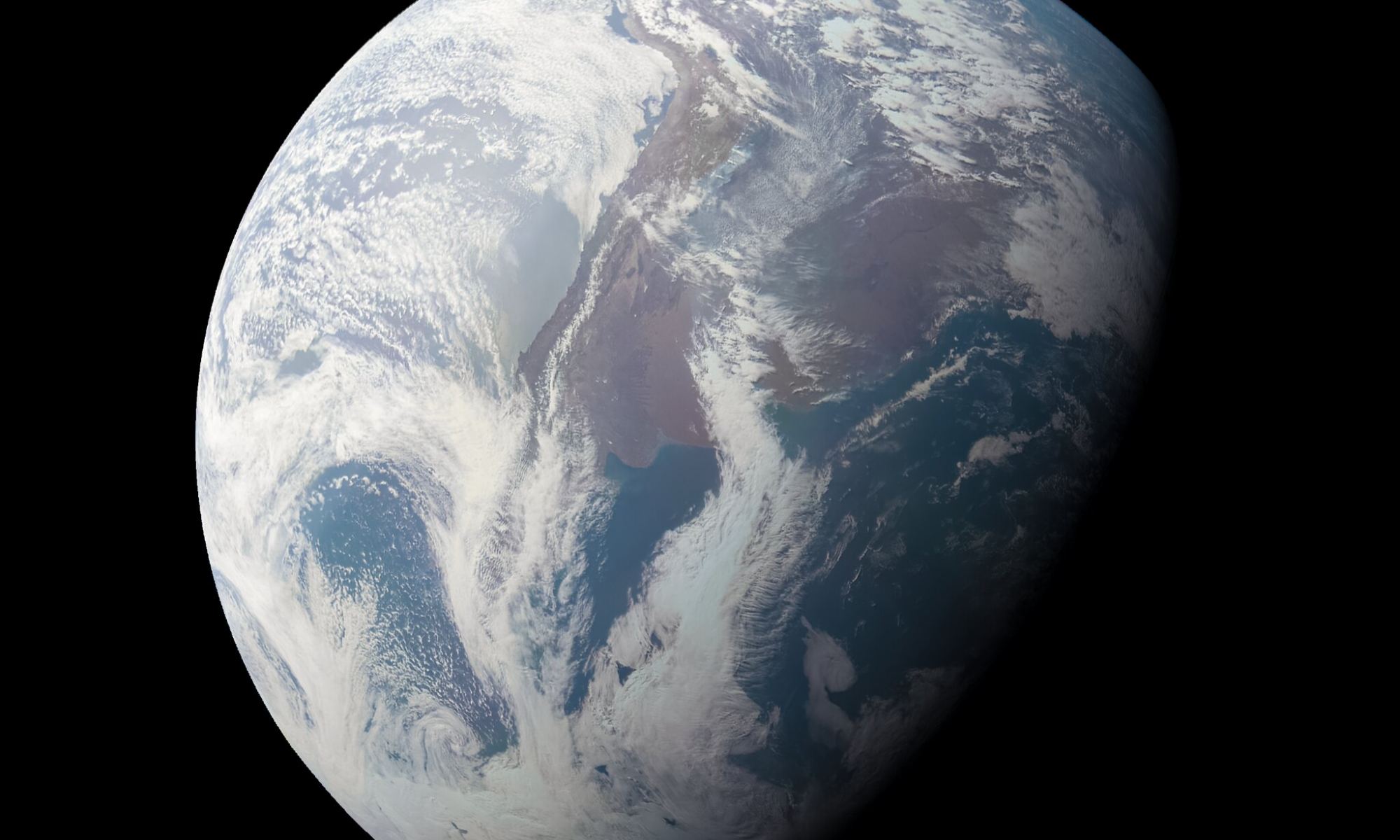Where did Earth’s water come from? That’s one of the most compelling questions in the ongoing effort to understand life’s emergence. Earth’s inner solar system location was too hot for water to condense onto the primordial Earth. The prevailing view is that asteroids and comets brought water to Earth from regions of the Solar System beyond the frost line.
But a new study published in the journal Nature Astronomy proposes a further explanation for Earth’s water. As the prevailing view says, some of it could’ve come from asteroids and comets.
But most of the hydrogen was already here, waiting for Earth to form.
To understand the origin of Earth’s water, scientists study its isotopic compositions. Not only Earth’s water but also the evidence of water in meteorites, asteroids, and anywhere else in the Solar System they find it. In this new study, scientists developed a novel technique to determine the isotopic composition of water in the most ancient meteorites ever found.
The study is “Determination of the initial hydrogen isotopic composition of the solar system.” The first author is Jérôme Aléon, a researcher at the Institut de Minéralogie, de Physique des Matériaux et de Cosmochimie (CNRS / MNHN / Sorbonne University).
Scientists have known about isotopes since the early 20th century. There are three naturally occurring isotopes of hydrogen: 1H, 2H, and 3H. 1H and 2H are stable, while 3H is unstable. The three hydrogen isotopes are also called protium, deuterium, and tritium. Water contains different amounts of the three, especially protium and deuterium. Scientists express these relative amounts as a ratio. The D/H ratio is the ratio of deuterium to hydrogen. (Researchers often use the terms 1H, protium, and hydrogen interchangeably.)
Deuterium can take the place of hydrogen in the water molecule. When deuterium takes hydrogen’s place in a quantity of water, it’s called heavy water. Earth water only occasionally contains H2O molecules with deuterium rather than hydrogen.
We know the D/H ratio of water on Earth to an exact degree. It’s 1.5576 ± 0.0005) × 10-4. The ratio is a fingerprint scientists use to compare Earth’s water with water reservoirs elsewhere in the Solar System. For example, hydrogen contained in minerals inside ancient meteors, though it’s not water, can have different hydrogen isotope ratios that reflect the D/H present when the minerals form.
That fact is at the heart of the new study. We can turn the clock back to the Solar System’s formation to understand this research. Back to when the Sun was born in a molecular cloud.
After the Sun took shape in that cloud, it was surrounded by a smaller collection of gas called a solar nebula. The planets formed from the material in the solar nebula. This new study focuses on the 200,000 years after the Sun formed, but before any planetary embryos formed. To understand that time period, the researchers examined calcium-aluminum-rich inclusions (CAI) in a type of meteorite called carbonaceous chondrites.
CAIs are the oldest rocks we have. The minerals inside them are some of the first solids to condense out of the protoplanetary disk. They’re 4567.30 ± 0.16 million years old. Scientists use CAIs to define the Solar System’s age because they date back to the primordial Solar System before planets formed.
In this study, the researchers measured the isotopic composition of hydrogen in the CAI’s captured minerals. Those measurements determined the isotopic composition of hydrogen at the birth of the Solar System. The minerals captured inside the CAI are called xenoliths. Xenoliths were captured inside the CAIs while cooling from a magma state.

The researchers measured the H isotopic composition of individual micrometre-sized xenoliths from E101.1 using Nanoscale Secondary Ion Mass Spectrometry (NanoSIMS.) Their goal was to measure the D/H fingerprint of these minerals.
In an e-mail exchange with Universe Today, lead author Jérôme Aléon explained the study’s results. “We focused on the xenolith because it was trapped in the host CAI in the solar nebula; hence it provides a good record of what happened in the solar nebula,” Aléon said. “In the xenolith, we measured several types of minerals that show up with different hydrogen isotopic compositions.”
Why would the xenoliths have different isotopic fingerprints? Aléon explained what’s behind the different isotopic compositions:
“All primary minerals formed by condensation from the solar gas turned out to have low hydrogen content and also to be depleted in deuterium with the endmember composition being similar to that expected for the main solar nebular gas. So most likely they trapped a little bit of solar nebular hydrogen during their formation,” Aléon said.
But the primary minerals didn’t remain in that state. A lot was going on in the young Solar System. Things weren’t static. A second type of mineral formed based on the primary minerals.
“A second type of minerals formed from the primary minerals and were enriched in iron in oxidizing conditions. These minerals turned out to have (1) relatively high hydrogen content and (2) isotopic composition similar to that of the Earth’s water. So they formed in oxidizing conditions in the presence of water vapour having the isotopic composition of Earth water,” said Aléon.

So now we have CAIs with minerals containing water records with two separate isotopic fingerprints. The first type matches the D/H ratio of the solar nebula, and the second type more closely resembles the D/H of Earth’s water.
But the Solar System wasn’t done modifying the D/H ratios yet. Things changed again when the partially-molten CAIs captured the xenolith minerals.
“We found a third type of minerals that formed by reduction of the second type of minerals during the capture of the xenolith by the host CAI (hence necessarily in the solar nebula),” Aléon said. “These minerals (1) have low hydrogen content and (2) have a hydrogen isotopic composition fully understood by hydrogen loss during the capture of the xenolith. Their very existence and their isotopic composition thus testify that the second type of minerals with Earth-like composition indeed formed in the solar nebula before the capture of the xenoliths by the host CAI.”
This is complicated geochemical sleuthing. But it leads to a new understanding: there must have been two gas reservoirs in the Solar System’s very early history. And the xenoliths inside the CAIs encountered these gas reservoirs at different times.
“So we demonstrate the existence of two nebular gases that were encountered successively by the xenolith before its capture. (1) the solar nebular H2 gas almost devoid of deuterium and (2) a gas enriched in H2O with Earth-like isotopic composition,” Aléon explained.
The first gas reservoir is related to the Sun’s formation and the protoplanetary disk, and we find its fingerprint trapped in the primary minerals of the xenolith. But where did the second, distinct gas reservoir come from?

Aléon explains what happened. “Stars and their planetary systems formed from the collapse of cold interstellar clouds. In the interstellar medium, hydrogen is distributed in two “boxes.” Box 1 is the main H2 gas; it contains almost all hydrogen atoms and very little deuterium. This gas corresponds to the bulk of the solar nebula gas from which the Sun formed, and we find it trapped in the primary minerals of the xenolith.”
“Box 2 contains only a tiny bit of hydrogen atoms locked in molecules (such as water ice) formed at extremely low temperatures in the cold interstellar cloud. Because of these very low temperatures, they are very rich in deuterium, much more than the Earth,” Aléon said.
“So what we propose,” said Aléon, “is that the protoplanetary disk that formed during collapse (and inside which planets will ultimately form) becomes enriched in water from box 2, vaporized during infall onto the hot inner regions of the disk. This excess water produces a gas, which has the oxidizing conditions required for the formation of the second type of mineral and has the Earth-like isotopic composition (intermediate between those of box 1 and box 2) that is found in Earth water but in many other planetary objects as well.”
Their results show two reservoirs of gas in the early Solar System, both identifiable by their different isotopic fingerprints. One gas reservoir had an isotopic fingerprint different from Earth’s water. The second gas reservoir was enriched with water vaporized when it approached the inner Solar System. The vapour provided the conditions to oxidize the second type of xenolith mineral in the CAIs. Its isotopic fingerprint matches Earth’s water, which is partway between the D/H of the first part of the interstellar medium, which Aléon refers to as Box1, and the second part that he calls Box2.
“It was created by a massive influx of interstellar water in the hot internal regions of the solar system, upon the collapse of the interstellar envelope and the formation of the protoplanetary disc,” according to a press release accompanying the paper. “The early existence of this gas with Earth-like isotopic composition implies that Earth’s water was there before the accretion of the first constituent blocks of our planet.”

protoplanetary disk. The planetary H isotopic composition is produced during the collapse phase of the protostellar envelope by a massive influx of interstellar matter infalling directly in the inner Solar System. Image Credit: Aléon et al. 2022.
So as Earth formed, the deuterium-rich hydrogen was waiting.
“We report the hydrogen isotopic composition of nominally anhydrous minerals from CAI fragments trapped in a once-melted host CAI,” the authors write. “Primary minerals have extremely low D/H ratios, with ?D values down to -850‰, recording the trapping of nebular hydrogen. Minerals rich in oxidized iron formed before the capture of the fragments record the existence of a nebular gas reservoir with an oxygen fugacity substantially above the solar value and a D/H ratio within 20% of that of the Earth’s oceans.”
The formation of stars and planets is a massive event. It’s fascinating that tiny microscopic xenoliths provide a trail of clues that help explain these events. Does this study answer the question of the origin of Earth’s water?
It presents evidence that the well-accepted idea of how Earth’s water got here may not be as solid as thought. It’s the same with our understanding of how planets form.
Other lines of inquiry support the idea that Earth’s water was already here when the planet formed. Earth’s D/H ratio has increased over time, so the D/H ratio of Earth’s original water was lower than it is presently. This is consistent with the results of this new study showing that at least a significant portion of Earth’s water was here early in the planet’s life, rather than delivered later by comets and icy planetesimals.
More:
- Press Release: Earth’s water was around before Earth
- Published Research: Determination of the initial hydrogen isotopic composition of the solar system
- Universe Today: Did the Earth’s Water Come From the Sun?

